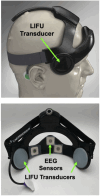Neurotechnology for enhancing human operation of robotic and semi-autonomous systems
- PMID: 40485770
- PMCID: PMC12141011
- DOI: 10.3389/frobt.2025.1491494
Neurotechnology for enhancing human operation of robotic and semi-autonomous systems
Abstract
Human operators of remote and semi-autonomous systems must have a high level of executive function to safely and efficiently conduct operations. These operators face unique cognitive challenges when monitoring and controlling robotic machines, such as vehicles, drones, and construction equipment. The development of safe and experienced human operators of remote machines requires structured training and credentialing programs. This review critically evaluates the potential for incorporating neurotechnology into remote systems operator training and work to enhance human-machine interactions, performance, and safety. Recent evidence demonstrating that different noninvasive neuromodulation and neurofeedback methods can improve critical executive functions such as attention, learning, memory, and cognitive control is reviewed. We further describe how these approaches can be used to improve training outcomes, as well as teleoperator vigilance and decision-making. We also describe how neuromodulation can help remote operators during complex or high-risk tasks by mitigating impulsive decision-making and cognitive errors. While our review advocates for incorporating neurotechnology into remote operator training programs, continued research is required to evaluate the how these approaches will impact industrial safety and workforce readiness.
Keywords: BCI; attention; cognition; human-machine; neuromodulation; neurotechnology; teleoperations.
Copyright © 2025 Tyler, Adavikottu, Blanco, Mysore, Blais, Santello and Unnikrishnan.
Conflict of interest statement
WT is a co-founder of IST, LLC and inventor of patents covering neuromodulation methods and devices, which are described in this manuscript. The remaining authors declare that the research was conducted in the absence of any commercial or financial relationships that could be construed as a potential conflict of interest.
Figures






References
-
- Adami P., Rodrigues P. B., Woods P. J., Becerik-Gerber B., Soibelman L., Copur-Gencturk Y., et al. (2021). Effectiveness of VR-based training on improving construction workers’ knowledge, skills, and safety behavior in robotic teleoperation. Adv. Eng. Inf. 50, 101431. 10.1016/j.aei.2021.101431 - DOI
-
- Aggravi M., Pausé F., Giordano P. R., Pacchierotti C. (2018). Design and evaluation of a wearable haptic device for skin stretch, pressure, and vibrotactile stimuli. IEEE Robotics Automation Lett. 3, 2166–2173. 10.1109/lra.2018.2810887 - DOI
-
- Aguilar Reyes C. I., Wozniak D., Ham A., Zahabi M. (2023). Design and evaluation of an adaptive virtual reality training system. Virtual Real. 27, 2509–2528. 10.1007/s10055-023-00827-7 - DOI
Publication types
LinkOut - more resources
Full Text Sources

